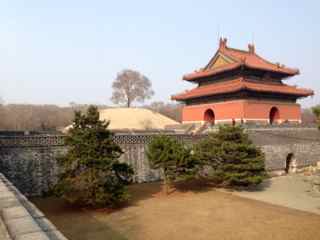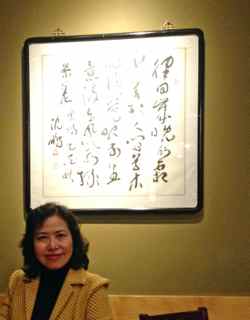Bill Lee
From March 25 to 30, I made another short visit to China — this time to Shenyang in northeastern China and Beijing. The icy relations between Japan and South Korea began to thaw slightly when Prime Minister Shinzo Abe and South Korean President Park Geun-hye met together with President Barack Obama in Geneva at the Nuclear Security Summit at his urging. Prime Minister Abe made a statesmanlike gesture by greeting President Park in Korean, but Abe still sends mixed signals on the sex slave and other issues, and Park appears intent on proving to her constituency in South Korea that she is not pro-Japan, as her father was. There was also a resumption of official talks between Japan and North Korea after a long hiatus. President Xi Jinping was in Europe for a grand tour, grabbing headlines in the China media for enhancing China’s global presence, while at home unprecedented corruption cases were building against very high-level former and current Chinese party officials.
Shenyang
The infamous Mukden Incident, when the Japanese Imperial Army allegedly blew up part of a railway as a pretext for invading Manchuria, occurred near Shenyang, then called Mukden. A large memorial marks the spot, with the date of the Incident, September 18, 1931, etched deeply and dramatically in the memorial wall. In Shenyang last month, Japanese and North Korean officials met to discuss the abduction issue, which Japan keenly wishes to resolve, but the negotiations are seen as creating a possible rift between Japan and its partner countries the United States and South Korea. Shenyang is also fairly close to North Korea, and a noticeable Korean presence exists in the city. For many observers of North Korea, a Hamletian dilemma grips them as they question whether to engage or not to engage the DPRK. The official US line is that North Korea should not be engaged, considering their supposed reneging on past agreements that has made the United States conclude that it “would not buy this horse for a third time” (then Defense Secretary Robert Gates), unless they agree to negotiate an end to their nuclear program. In an article in NK News, B.R. Meyers says, “No tour group [to Pyongyang] is complete without at least one suck-up.” A suck-up is one who bows to the statue of Kim Il Sung, as used to be required a number of years ago, apologizes for US actions against the DPRK, or otherwise tries to engage North Korea. In the US State Department, being labeled an “engager” of the DPRK is probably a kiss-of-death career-wise. Meyers likens engagers to the foreign visitors to the 1936 Berlin Olympics who went home “with a better view of Hitler than before,” or as Neville Chamberlains. Engagement is seen as propping up the status quo; isolation or boycotts are the answer. Certainly boycotting South Africa helped to dismantle apartheid, but the problem is that North Korea is already isolated; further isolating it will likely have no effect if China continues its infusions of aid.
Articulate North Koreans can make a strong case for engagement. Some “officials” can become quite expansive, but not unguarded, in expressing themselves, especially if they feel some bond of trust with their interlocutors. When asked about Dennis Rodman’s recent visit to the DPRK, one official said, with some embarrassment, “Anyway, he is gone and that is over.” On the current situation in the DPRK, one immediately said that they had “gotten rid of” Jang Song Thaek because he had “mismanaged” the economy, only wanting to build hotel resorts, and promote himself. One wonders how closely associated Jang was with the newly built luxury ski resort in North Korea. Did sour business disputes precipitate Jang’s fall, as the main South Korean intelligence agency claims? Jang wanted to open up the country to gain foreign currency, and a ski resort would fit that bill. But on the other hand, Kim Jong Un was seen touring the facility, clearly enjoying himself and deeming it “at the center of the world’s attention.” One can only speculate; that is the nature of the game.
North Koreans are also grateful to George W. Bush. Because of his administration’s veiled threat to destroy North Korea, the North Koreans felt justified in developing their nuclear weapons for protection. They are more ambivalent about somebody like Bill Clinton. North Korea also believes the United States is using North Korea as the “bad boy” in Asia to explain its presence there and “justify its arms buildup.” Apparently, North Korea would negotiate with the United States on two conditions: the signing of a peace treaty and compensation to North Korea for “Cold War debts.” One North Korean said, perhaps straining credulity, that North Korea “wants to become like Switzerland” and could become a buffer between the United States and China. Could North Korea become America’s friend? Why not, say the North Koreans. The United States now has friendly relations with Vietnam, its former enemy (not to mention Japan). A final bit of North Korean Yin/Yang wisdom: “Don’t make friends; recognize them,” and “Never accept anything; but don’t refuse anything.”
We saw some main must-see sights in Shenyang. The former residence of Zhang Zuolin and Zhang Xueliang is an interesting compound filled with period receptions rooms, offices, and houses and bedrooms for the various wives of the two warlords of Manchuria. Zhang Zuolin, the father, was assassinated by the Japanese to allow his then opium-addicted son, Xueliang, to take power because they thought he would be more malleable. But that didn’t turn out to be the case as Xueliang transformed himself into a fervent patriot, and even kidnapped Chiang Kai-shek in 1936 — the Xian Incident — to get him to join forces with the Communists to drive out the Japanese invaders. He was later exiled to Taiwan and ended up in Honolulu, where he lived to 100. Legend has it that Xueliang flipped coins, which are lovingly preserved, to decide whether to assassinate two officials considered too pro-Japan. The two officials lost the toss.
In Shenyang, one must of course visit the Imperial Palace, a vast complex and the only existing royal palace in China other than the Forbidden City. Like the palace complex in Beijing, the Shenyang Imperial Palace is meant to impress, which it grandly does with its sweeping spaces, high walls, and imposing buildings. Shenyang’s air was quite polluted so it was a welcome respite to go to Beiling Park, where the Zhaoling Tomb is located. The Tomb is a vast area, divided into three parts, and filled with pine trees, a moat, gates, and pavilions, it offers a tranquil refuge from the city. At the northern end of the park is the Underground Palace, the tomb of the Emperor and his wife, which sits under the Treasure Top, a man-made hill, which one walks around along the “crescent” path. Of discordant interest was the presence of two cosplay girls, in full anime regalia, being photographed by a pack of men with expensive cameras.
 Treasure Top at the Zhaoling Tomb. Note the solitary tree at the top of the mound.
Treasure Top at the Zhaoling Tomb. Note the solitary tree at the top of the mound.
Food in northeastern China is hearty, with meat stews, pork “tempura” – razor-thin slices of pork fried in batter — and the delectable pan-fried crepes stuffed with Chinese chives and shredded shrimp.
Going to Beijing by high-speed train was worthwhile, if nothing more than to compare the ride with the journey from Beijing to Shanghai. The train for the latter trip is usually filled with businesspeople, who tend to be quieter, thinking about their business deals. But the trip from Shenyang appears to bring the northerners to Beijing, which makes for a more raucous and vivid journey. One tip: buy a box lunch in the dining car early-on because they sell out fast and only frozen lunches are left.
Among other places in Beijing, we walked around the campus of Renmin University, where it was interesting to see the students reciting English out-loud repeatedly, which is why Chinese students are better than Japanese students at English, ate chocolate at Godiva’s Beijing flagship store, enjoyed a massage with a young woman stepping on your back, and strolled around the Houhai district, where a lot of bars — some featuring eye-catching pole dancers near the entrance to draw you in — cafes, and “live” houses are located.
I also realized why so many Chinese people want to shop in Japan, the States, or Europe. It’s not because the goods are necessarily better there; they’re cheaper. I wanted to buy some carry-on luggage, thinking it might be cheaper, but found that in the up-scale department stores, the luggage was about three times more expensive than what I could get in the US, granted, though, it was better quality. Income disparities notwithstanding, it’s great to be the second biggest economy in the world.

ShaoMing Ou, RG21 Publisher
 日本語
日本語 English
English 中国語
中国語